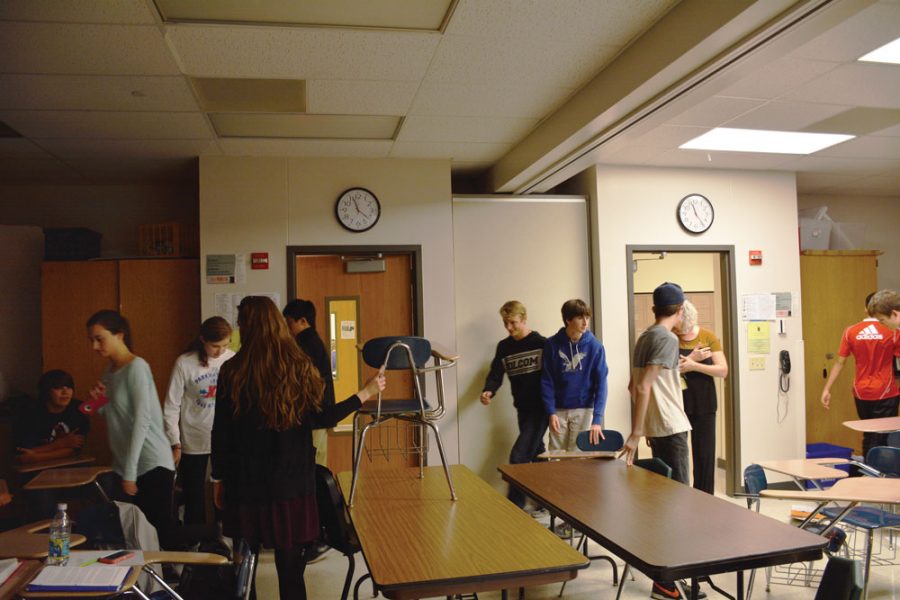[dropcap]E[/dropcap]ver since school resource officer Keisha Edwards arrived at RBHS in January 2011, her efforts in maintaining the school’s safety is always her top priority. As a way to ensure student and staff safety, her first years at RBHS involved rehearsing fire, tornado, intruder and earthquake drills.
Her job during all of these drills was to provide assistance where it was needed around school during the drills. On top of this, the addition of the Active Shooter Response Training (A.L.I.C.E drill) six years ago requires even more clear communication and specific procedures in the case of an actual emergency.
“My job is to assist where [I am] needed and to be out in front of the school to communicate with responding members of public safety,” Edwards said. “[During the A.L.I.C.E drill], I usually follow the ‘bad’ guy to see what he/she sees. [This way] I can implement ways we can be better at evacuating the building.”
If a real active shooter were in the building, Edwards said her main job would be to go to the threat and remove it. She emphasized how practicing all of the drills is vital because real situations could happen at RBHS.
Edwards and assistant principal Dr. Tim Baker both believe in the importance of having people know how to respond in emergency situations. Baker also believes the first priority of the school administrators is to ensure that the students are safe and the numerous drills help achieve that goal.
“We [practice] many different types of drills, including fire, modified lockdown, tornado, bomb threat, A.L.I.C.E and earthquake drills,” Baker said. “In the summer, I schedule all the drills for the year. I do my best to avoid any really busy days at RBHS and all testing days, [but] there are mandatory dates and a mandatory amount of times that we have to conduct.”
Baker said RBHS must follow Missouri state policies which address what drills are mandatory to practice and how many times the drills should happen. Baker said the policies RBHS follows require at least 10 fire drills, two active intruder drills – A.L.I.C.E – and modified lockdown as well as at least one earthquake and tornado drill to be conducted. During the drills where student and staff exit the building, Baker and the other school administrators split into crisis groups of 15 members who are located around all exits of the building. Using radios as the primary way of communication during all drills, all of the teams report to Baker via the radios once their areas are secured and safe.
“At least in high school, we don’t account for every student outside,” Baker said. “We simply make sure everyone exits the building and each room is empty. Once classes are back in the building, if a teacher is missing a student, [he or she] informs us, and we look for them at that time.
As Baker said, the rehearsing of the drills often interrupts classes for students like sophomore Ismael Rashid. He finds most of the drills successful for what they are meant to prepare for, and believes it is very important to rehearse the drills.
“Whenever a drill is announced over the intercom, I feel relieved that I get to miss some time from my class period,” Rashid said. “But, I also feel safe knowing that my school takes drills very seriously, especially considering the world we’re living in today.”
During the A.L.I.C.E drill, Rashid found the entire rather experience short and boring. Rashid still understands the importance of practicing the event of dealing with an armed and active shooter.
“In my opinion, [the A.L.I.C.E drill] was an important drill for the school to practice because situations are going to occur when a suspicious person enters a school,” Rashid said. “In that time, practice is needed for such situations so that the whole school is able to evacuate safely and quickly to minimize possible casualties. At the same time, creating a [larger] sense of realism will make all of the drills more effective. Oftentimes, students [including] myself included don’t take drills as seriously as they should and they won’t be as fully prepared as they should be if such a day were to arise.”
Baker and all of the school administrators don’t plan on stopping the rehearsals of drills anytime soon. Baker wants to ensure that everyone in the school building will be prepared and ready for any real life situation by continuing to practice the drills that have already been instilled in the school’s routine.
“The best case is that every teacher and student knows what do without really thinking about it, and the drills become second nature,” Baker said. “That way if we ever had a real emergency, then everyone would be safe [and] that’s the goal.”














































































Rachael Erickson • Nov 15, 2017 at 1:55 pm
I find it really interesting how we’re required to do five times more fire drills than ALICE drills, considering the prevalence of active intruder scenarios, and the relative unlikelihood of a massive fire scenario.